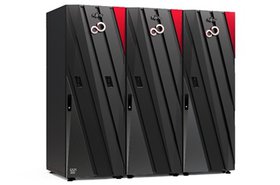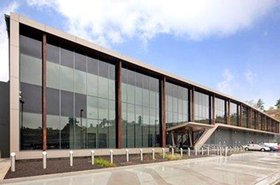The data explosion of recent years has not only been in the sheer scale of largely unstructured data in storage, which analyst group IDC expects to reach 150 zettabytes (150 trillion gigabytes) within three years, but the number of facilities required to house those racks of servers and storage devices. It is estimated that energy used purely for data storage will account for as much as four percent of total global emissions by 2025 – dwarfing the 2.4 percent produced by the entire global airline fleet.
As countries and businesses rush to meet strict environmental targets, reduce emissions and keep global warming at an acceptable level, every organization has a responsibility to make intelligent decisions about their data storage and compute, finding new and innovative ways to cut carbon generated by data centers – both in their construction and operation.
Fujitsu is a global leader in data management and has a long history of finding efficiencies to improve productivity for clients, whilst reducing impact on the environment. Gavin Dudley, Fujitsu’s head of portfolio for data centers in the ANZ region, explains some of the more environmentally sustainable ways to improve your data throughput.
Environmental impact starts with the build
Your contribution to global emissions begins with how you construct your data center. Purely considering how it operates once built is not enough, according to Dudley.
“Some research suggests that you would typically generate about 128 tonnes of carbon in the construction of a one-megawatt data center (embedded Green House Gases), and then another 128 tonnes, more or less, of carbon from the build activity such as the use of petrol and electricity (Bouley, 2010), (M P Bhorkar et al, 2021).
“Using electricity on drills, equipment, driving to and from the construction site – diesel in the vehicles, all of those types of things, running construction equipment and tools – it all adds up. For a typical one-megawatt data center, the carbon intensity to build equates to about 250 tonnes of carbon when both the embedded carbon and the GHGs generated from the process of construction are considered.”
So how do you cut that figure down? It could start with refurbishing existing facilities to be more efficient, rather than hiring a bulldozer and starting again. Whether that’s the cheapest way is another matter, but from an environmentally responsible point of view, Dudley suggests that nothing should be off the table.
“Designing a data center so that it can accommodate newer cooling technologies, like liquid or immersion cooling is a hugely beneficial option,” says Dudley.
You may be thinking that retrofitting sounds expensive and may not produce a result equivalent to what you’d hope from a new build – but don’t rule it out.
“When we make these decisions, you need to consider a number of parameters, including sustainability. And there are lots of data centers where the physical structure isn’t the impediment. It’s the design of the interior walls. It’s the insulation, it’s the mechanical systems and spaces, it’s the access to water. Often a renovation can be a viable option.”
That said, if you do need a brand-new data center, or a refurb simply isn’t an option, it’s the design of the building and the layout of the interior that will make the biggest difference to your environmental impact. Dudley lays out some aspects to focus on:
“Running a one-megawatt data center in Australia generates around 5,800 tonnes of carbon per year (based on current average carbon intensity in the national grid supply) (Clean Energy Regulator, 2022). So, yes, you should be focused on carbon around the construction of the data center. But to my mind, it’s about making the operations of the data center as efficient as you can, because that’s where the real benefits are realized.
“It’s about getting the carbon intensity of the generation and the consumption of the electricity down, and making the data centers as efficient as possible, in order to enable efficient cooling and efficient consumption of electricity.
“Sustainability is not just about electricity. Water usage effectiveness and efficiency is also incredibly important in the running of data centers. Creating a data center that minimizes emissions is also very, very important. Consider a design that capitalizes on air exchangers rather than air conditioning with water towers in cooler climate regions.”
Water is life
Data center cooling comes in many forms, some of which are more complex to implement than others, says Dudley.
“My general view is that liquid cooling should always be high on your list due to its inherently lower carbon intensity per kW of cooled power (Arden L Moore, 2014), and there’s now lots of different versions of liquid cooling.
“There’s straight liquid cooling, which is literally running pipes over the hotter parts of your server, like the CPU and GPU. Straight liquid cooling, rather than immersion cooling, is good to about 40 or 50 kilowatts per rack.
“Then there’s immersion cooling, where you stick the whole lot into a tub of thermally conductive but electrically insulating dielectric liquid. The dielectric fluid looks like water, so seeing expensive electronic components in what looks like a tub of water is a very strange and confronting sight! Immersion cooling is effective up to about 80kW per rack.”
While immersion cooling may typically use some form of mineral oil, water is often used as part of the process in the cooling as it is circulated around the system. Also, it is important to note that you still need ambient air cooling as well as liquid cooling, just not as much.
Big data, bigger impact
The bigger the facility, the bigger the impacts of decisions made regarding sustainability.
“We are quickly getting above the potential for 40-50kW rack densities; the latest high end CPU and GPUs can are rated at 500W and can be packed four to a circuit board; that is 2kW in one server that is two rack units high.
“That is very dense heat load and creates real problems for heat dissipation. This will start to drive adoption of liquid cooling uptake,” says Dudley.
“But if you start to get above 50 kW per rack, then immersion cooling is really going to be the next phase of cooling things, but that comes with its own inherent challenges: many data centers were not designed to have the raised floors that large tubs of fluid require. Server fans also need to be disabled or removed, potentially generating unclearable errors.”
If liquid cooling isn’t practical, there are still other ways to maximize the efficiency of your data center, by optimizing for airflow and being strategic in the way the heat load is distributed.
Additionally, modern CPUs are more tolerant to higher temperatures, allowing the ambient temperature in the data center to be raised without impacting the operation of the CPUs. for example raising the ambient temperature by as little as 0.5 degrees Celsius could reduce cooling costs by up to five percent.
“Firstly, don’t cram racks side by side. Of course, there’s hot and cold containment and there’s the need to optimize airflow around servers. There’s lots of other different things we can do in the design, such as the most efficient way to cool whatever equipment a client turns up with, and that’s certainly part of our ethos for data centers.
“If clients arrive who haven’t gone down the liquid cooling or immersion cooling path, if they arrive with an open mind to work with the data center engineers to optimize airflow around their equipment in the racks, that will also help with cooling.
“So being open to having some gaps in the racks, having space between racks – lots of different things can be done to improve airflow. I think it’s also about clients being willing to accept slightly higher temperatures and slightly higher humidity, in line with what’s now considered to be an acceptable amount by international standards (ASHRAE, 2021).”
Monitoring, transparency, and mobility
Of course, you can’t manage what you don’t monitor. If you don’t know the level of GHG emissions your organization is generating, you will be severely limited with regards to the improvements that can be made.
It is therefore essential you have your eye on not only your Scope 1 and 2 emissions (emissions essentially owned or controlled by your organisation) but your Scope 3 emissions as well – those that are a consequence of the activities of your organization but occur from sources not owned or controlled by the organization itself.
Fujitsu globally has committed to being carbon neutral by 2050, with an interim target to reduce Group-wide carbon emissions by 71 percent by 2030 (against a baseline year of 2013). Fujitsu’s emissions reductions targets are aligned with the science of holding to 1.5 degrees warming and are endorsed by the global Science Based Targets initiative (SBTi).
In Australia, 98 percent of Fujitsu’s Scope 1 and 2 emissions are attributable to electricity consumption at its fleet of six data centers.
That’s why Fujitsu Australia is reducing its emissions footprint through activities such as:
- Procuring renewable energy through power purchase agreements (PPA). In June 2022, Fujitsu’s first PPA went live, which is projected to reduce their reportable Scope 2 emissions by approximately 50 percent. This helps data center customers with a corresponding reduction in their indirect (Scope 3) emissions.
- Energy efficiency projects to reduce energy and costs to its customers. Fujitsu remains the only Australian company to certify its entire data center portfolio against the NABERS energy efficiency rating – and Fujitsu averages more than 4 Stars under NABERS across its data center fleet.
- Investing in rooftop solar, for example, in 2020 Fujitsu installed a 99kW solar PV system on the roof of their Brisbane data center.
- Making carbon offsets available for data center customers, and offsetting the fuel-related emissions of its ~150 vehicle commercial fleet.
Fujitsu tracks and reports on its Scope 1 and 2 emissions and has commenced recording aspects of Scope 3 ‒ for example, emissions from flights and hire cars. Dudley reports:
“We are working on a project to map the boundaries of our Scope 3 footprint. Once the report is complete, we will be collaborating with our suppliers on ways to reduce their emissions.”
This kind of transparency helps to foster trust between data center and client, a vital commodity when dealing with mission-critical facilities. Another crucial part of that trust-building process through transparency is the ability to demonstrate that the environment inside a facility is ideal.
“Regular thermal testing, including down inside the rack level, allows for optimized airflow, maximizing cooling where it’s needed. Racks continue to improve, some including options for dynamic heat load monitoring and power management at the rack unit level. Having a very sound engineer working with the client is critical,” says Dudley.
He continues: “We’ve got clients where we regularly run air cooled 25 kilowatt racks, and as long as we get the airflow right through those racks, it’s a very efficient way of cooling, short of going to water cooling or liquid cooling, providing you do some aisle containment and manage the airflow as efficiently as possible.
“Unfortunately, workloads move around in the data center, and this also affects power, and therefore heat generation. Workloads tend to have ‘gravity’. So, someone has one rack they’re hammering this month, but not the rack next to it, and then it moves around and heat density in the data center therefore moves around, even if you’ve not moved any of the cabinets or any of the equipment in the cabinet.
“So having a regular revisit, and retuning of the airflow is critical. It’s important for our engineers to be able to do it every three to six months. If necessary, they need to be able to focus airflow for effective cooling and electricity usage.”
Power and water
Not all electricity is created equal. Each supply has its inherent embedded carbon intensity which can vary dramatically between states. With coal and gas currently in high demand around the world, and many electricity generating plants still relying on it, it might be worth considering locating your facilities in jurisdictions with a higher level of renewable energy, such as wind, solar, and hydro-electric (Clean Energy Regulator, 2022).
“Different states in Australia have different carbon intensity in the electricity that is fed into the grid.
In Tasmania, for example, the grid supply has the lowest carbon intensity of any Australian supply, with a carbon intensity of around 160 grams per kilowatt hour (Clean Energy Regulator, 2022).
“The Australian average is about 664 grams per kilowatt hour, so four times as much. In this sense it would make sense to place more DCs in Tasmania, but other factors, such as limited access to staff due to the lower population, global fibre connectivity, and latency, are some constrains to be considered.
“It is important to understand the carbon intensity of the grid that supplies the data center, including government policy and market forecasts which can heavily influence the rate of decarbonization in a given state.”
Adding in the need for water for cooling, Dudley advises to not only assess the current availability of water infrastructure and supply, but also the projected potential water stress levels, which are influenced by climate change.
Sustainability beyond environmental responsibility
The solar panels on Fujitsu’s Eight Mile Plains data center in Queensland were installed by Bunjil Energy, an Indigenous-owned business, reflecting ongoing commitments to both sustainability and reconciliation.
“At Fujitsu, our purpose is to make the world more sustainable by building trust in society through innovation. So we can live that purpose, Fujitsu has established a dedicated ‘Office of Purpose’, which delivers positive impact and synergies between environmental sustainability, diversity, equity and inclusion, and community engagement, both within our business and for our customers and society,” says Dudley.
There are many complexities and challenges for leading organizations to face beyond environmental responsibility, but including First Nations-owned businesses in the supply chain ensures diverse groups are able to participate in economies that will become increasingly important in the future.
Locating data centers and service hubs away from urban areas can also help the local economy by bringing job opportunities to underserved groups. Working in Australia gives Dudley demonstrable experience of this with the country’s Indigenous community.
“Through our Office of Purpose we’ve developed a relationship with the Cherbourg First Nations community and established a service center within that remote community, alongside TAFE Queensland, Australia Post and the local and state governments.
“We’re teaching digital literacy and customer service skills to First Nations people in a place that doesn’t have a lot of jobs, and of course, a call center can be a remote thing, so we’re able to reach a community that would otherwise be cut off from great job opportunities.
“There’s an immense amount of talent in First Nations communities that is unappreciated due to their remoteness, but we’re lucky enough to experience this talent firsthand and pass it on to our customers through the support they receive from the Service Center.”
Dudley goes on to tell us that Fujitsu is also partnering with its client Woolworths to deploy “Mini-Woolworths” in schools for children with developmental needs to practise professional and life proficiencies.
“These mini-supermarkets are about making the trip to a supermarket less daunting for these kids, so they understand the processes can learn real world skills.”
This particular program has since been extended, so that these mini-supermarkets can also function as a learning and educational tool for future job-seekers ‒ a first of its kind opportunity to assist adults seeking meaningful, long-term employment.
The idea behind each of these purpose-led initiatives is to create a prosperous and sustainable future for society as a whole by harnessing the power of technological innovation, which Dudley explains is a core focus for Fujitsu.
“This is the very essence of Fujitsu’s Technology and Service Vision. Earlier in 2022, Fujitsu commissioned Forrester Consulting to conduct a global survey to explore the state of sustainability transformation and how digital transformation is enabling this change.
“The survey responses confirmed what we had suspected: that data and digital technology capabilities are key enablers of sustainability transformation. Across all industries and geographies, leading sustainable organisations around the world are applying digital tech across environment, social and governance aspects of their sustainability strategy, for example:
- Monitoring CO2 emissions within the organizations and through the value chain,
- Ensuring safety of workers on site
- Ensuring traceability in the value chain.”
It’s clear that simply installing LED bulbs and migrating to low-energy SSDs is no longer going to cut it when it comes to sustainability. The future of data, our planet, and the people on it relies on a holistic, collaborative approach to the problem from the ground up.
The ability to make a real and lasting difference ultimately stems from what we value. Fujitsu has an ambitious purpose to use its technological expertise to bring about positive environmental and social impact for the world. And how the company builds, operates and optimizes its data centers is a key way Fujitsu demonstrates this purpose in action.
Click here to find out more about Fujitsu’s sustainability transformation.
More from Fujitsu
-

Sponsored Key considerations for your hybrid and multi-cloud strategy in 2022
Been putting off the move to a hybrid strategy? Now is the time to make the leap
-

Fujitsu retains mainframe support contract for UK’s Police National Computer
PNC still waiting to be decommissioned after NLEDS delays
-

Sponsored Data centers: another page in Fujitsu’s diverse ICT portfolio
If data centers don’t immediately spring to mind when you think Fujitsu, we’re going to tell you why they should
